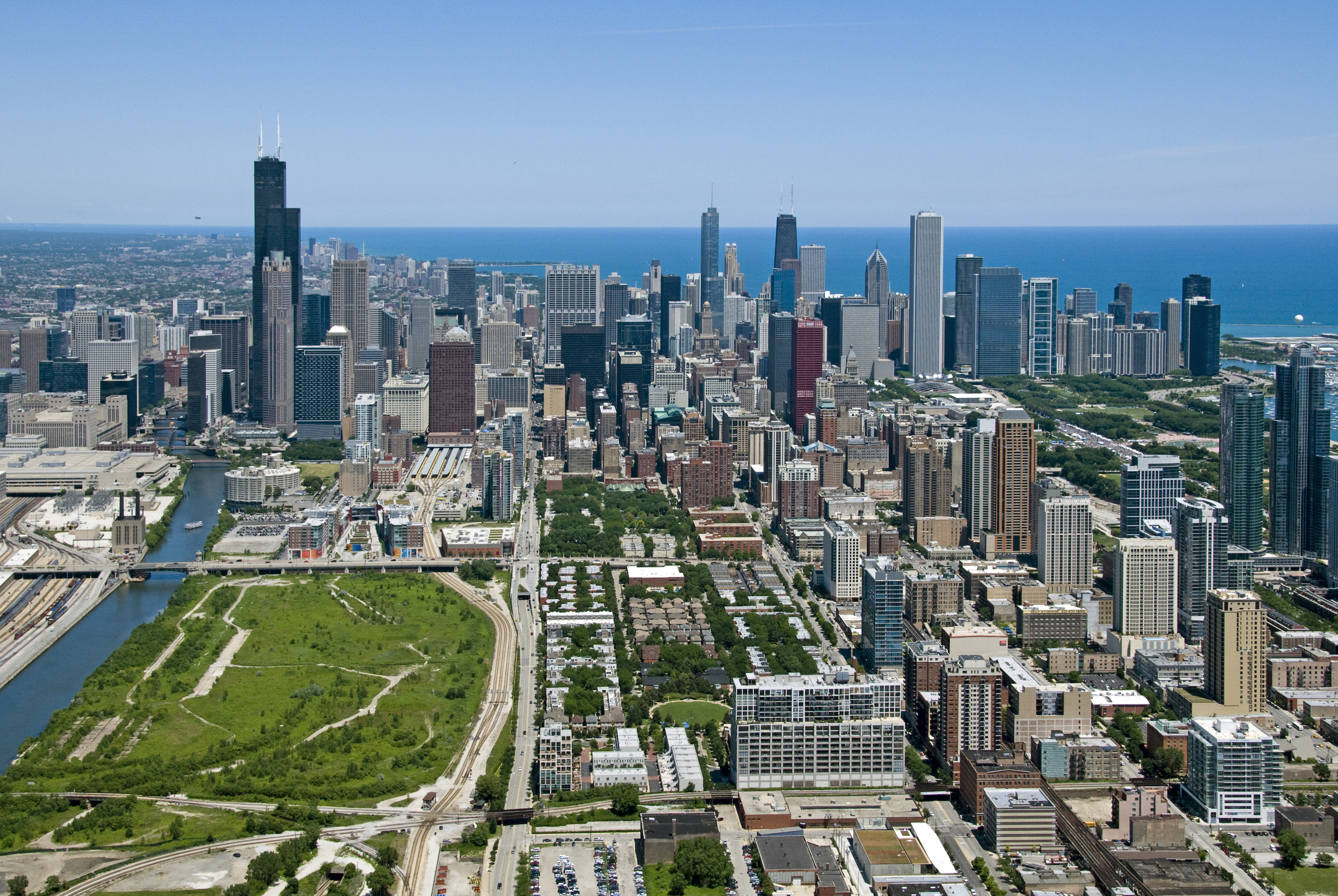The drawing received an honorable mention in a competition sponsored by The Chicago Tribune to envision the future of the city’s public housing. The girls’ plan was surprisingly prescient: beginning in the mid-1990s, the city began demolishing nearly 19,000 derelict housing units, including the “very bad drug building” and the high-rise where Rachella and Kimberly lived. Under the $1.6 billion Plan for Transformation, officially inaugurated in 2000 under Mayor Richard M. Daley and U.S. Department of Housing and Urban Development (HUD) secretary Andrew Cuomo, the Chicago Housing Authority (CHA) promised to return 25,000 units of rehabilitated or new housing to the city, most in the form of low-rise and low-density development, much of it mixed-income. In place of towers at the Cabrini-Green site on the Near North Side, not far from the affluent Gold Coast, there are now neat rows of two-story attached houses. In place of corner grocers and liquor stores, the neighborhood boasts a Target and a Starbucks. It even has a clock tower.
But despite these signs of success, the Plan for Transformation has been far from flawless. Although the CHA is 88 percent of the way to its goal of 25,000 housing units, implementation has dragged on for 15 years, with no clear end in sight. The mixed-income model backed by the plan also has achieved varied success and has left many residents confined to racially and economically segregated parts of the city. And even if the agency completes the remaining housing units, it will still have to contend with the increasingly urgent need for low-income and affordable housing in the city: last year the CHA’s wait list for housing assistance was the longest in history—within the four-week application window, 282,000 Chicagoans applied, including nearly 16,000 homeless residents.
Chicago’s infamous high-rises, built from the 1940s through the ’60s, had optimistic beginnings, reflecting modernist idealism and the national trend of urban renewal. Later, clustered as forests of desolate high-rises on the fringes of the city’s more prosperous core, places like Cabrini-Green and the Robert Taylor Homes came to symbolize gross economic and racial inequities, and the failure of government to provide for society’s most needy. By the 1990s, Chicago’s public housing contained 11 of the nation’s 15 poorest census tracts, the overwhelming majority of their residents African-American. In 1987, The New York Times published an op-ed piece about the West Side’s Henry Horner Homes, called “What It’s Like to Be in Hell.”
But some former residents remember Chicago’s projects from their brighter days. When Crystal Palmer moved into the Henry Horner Homes as a 9-year-old in 1968, she recalls, “It was beautiful.” The 19 brick apartment buildings, constructed between 1957 and 1961, were still fairly new. “There were grass, flowers, and respect for the development,” says Palmer, who now works for the CHA as a resident liaison. “We scrubbed our porches. We hung out on the breezeways as a family and watched the kids play and the young men on the basketball courts.”
Yet as the Henry Horner Homes, like so many Chicago projects, deteriorated, out of mismanagement and a lack of essential services, violence became a constant threat.
A 1994 study revealed that 40 percent of residents in one Henry Horner building had had a bullet enter their apartment in the previous 12 months. So badly managed was Sheltering Chicago that in May 1995, the entire CHA board resigned and HUD stepped in, the largest federal takeover of its kind.
The Plan for Transformation was intended as a clean slate for the CHA, after HUD handed control back to the reformed agency in 1999. The housing authority razed the notorious high-rises and created master plans with swaths of low-rise buildings on the projects’ footprints. Even the old names were erased: Henry Horner Homes became West Haven; Cabrini-Green became Parkside of Old Town; Robert Taylor Homes, Legends South.
Private developers built the new communities, incentivized by tax credits, on CHA property, through 99-year leases or land purchases. The developments were planned as mixed-income, which typically means one-third public housing (for those earning less than 30 percent of the area median income [AMI], or about $26,600 for an individual), one-third affordable (for residents who earn less than 80 percent of the AMI), and one-third market-rate.
The idea has been to foster diverse, safe neighborhoods with improved access to services, and to integrate the housing into the city fabric. Planners got rid of the superblocks where the isolated towers once stood and reintroduced the street grid.
But the new housing model is far from perfect. For some residents returning to these neighborhoods, the mixed-income ideal doesn’t foster the kind of tight-knit community they once knew, and they are not treated the same way as many of their new neighbors. Former public-housing residents who exercise a CHA-granted Right of Return, choosing to live in mixed-income communities, must undergo annual drug tests and abide by strict rules—including limits on where they can socialize—restrictions that do not apply to residents in higher income brackets. “People want to be treated with respect,” says Peter Landon, of Landon Bone Baker Architects, who has worked on new mixed-income housing and will soon begin to rehab a historic structure for the new National Public Housing Museum. “The CHA says ‘no hanging out on the front stoop.’ That’s crazy. It’s the culture of the neighborhood.”
Using private developers has also had an impact on the supply of public housing. When the recession hit in 2007, construction of the promised units stalled. “When we’ve shifted our public policies toward a market-based model, and those markets fluctuate, it puts at risk the provision of housing and the capacity for community and economic development, especially where urban poverty remains a reality,” says Amy Khare, a Ph.D. candidate at the University of Chicago School of Social Service Administration who is studying these issues.
Nowhere is the reality of economic development’s limits more apparent than at the former site of the Robert Taylor Homes, in the South Side neighborhood of Bronzeville, where 28 16-story towers once stood along the Dan Ryan Expressway. Frank Christopher Lee, principal at Johnson & Lee Architects—who grew up nearby and will correct you if you enunciate the term South Side (“it’s Sousside,” he says)—is teaming up with Landon Bone Baker Architects for the third phase of the redevelopment of Robert Taylor, the first phase of which was completed in 2007. On a recent afternoon, he drove past clusters of new mixed-income apartment buildings with manicured lawns, green saplings, and smooth sidewalks, and pointed out that his firm tries “to make the housing look like an established Chicago neighborhood.”
Yet these pleasant residential enclaves are punctuated by vacant lots, like gaps in a row of teeth. Behind one group of townhouses, kids kicked up dust on a baseball diamond in the middle of an otherwise barren tract. According to Khare, because so much of CHA’s land is in long-segregated neighborhoods that seem less economically favorable, it has been harder to attract the private developers on whom the authority now depends.
When CHA-owned land failed to attract the market-rate residential development that is underpinning new public housing, the agency modified its original strategy. Now, under the Plan Forward to create “communities that work,” the CHA has increased the disposition of its land (through sales or land swaps) to private developers for nonresidential commercial purposes. In June, Mayor Rahm Emanuel broke ground for a $9.8 million tennis complex on former CHA land on the South Side.
Despite its earlier management reforms, the CHA still has internal difficulties that have created distrust among many Chicagoans. A 2014 report by the Center for Tax and Budget Accountability, a nonprofit think tank, revealed that between fiscal years 2008 and 2012, the agency built up a total $432 million in reserves by not spending federal dollars on its housing voucher program. The CHA disputes these findings, claiming their reserves are a mere $220 million. Its interim chief executive officer, Eugene Jones Jr. (the agency has had five CEOs in the last four years), came under fire last month for dismissing the need for increased organizational transparency as “a waste of time.”
Today the future of the Cabrini-Green site is clear from the sounds of saws and hammering in the air, constructing new rentals and condos. The once-notorious area now blends into the surrounding neighborhoods. There’s an urban garden and maintenance crews with leaf blowers tending to the lawns and shrubbery. Only a few remaining vacant lots and a line of derelict rowhouses, part of the original complex, hint at its past. Last month, the CHA settled a 2013 federal lawsuit with the Cabrini-Green Local Advisory Council. Under the terms of the settlement, the rowhouses will be rehabbed, with no less than 40 percent of the total of 440 units devoted to public housing. Overall, the housing authority is obliged to raise the percentage of public housing from 30 to 33 percent for the greater redevelopment of Cabrini-Green.
Kimberly Davis, who reimagined Cabrini-Green with her best friend in 1993, now lives on the South Side, far from where she grew up. After attending St. Mary’s College, she started her own catering business. Not long ago, she explored the market-rate housing in one of the new Cabrini-Green developments. “I couldn’t afford to live there if I wanted to,” says Davis. “And when I applied for low-income housing, they said I was too successful.” Still, she says, “I would love to move back over there. Even after all of the hurt, Cabrini-Green made me all that I am today.”
Nearly 17,000 households were uprooted when the old projects came down, and the whereabouts of nearly 20 percent of these former residents is unknown. The CHA is still trying to track them down. In the August 31 edition of The Chicago Tribune, an advertisement appeared, with a blank box for former residents to fill in their Social Security numbers, in hopes that the agency can update its list of residents who lived in the projects until October 1, 1999. Residents have until December 6 to respond to the notice. After that, they will lose their Right of Return.












Post a comment to this article
Report Abusive Comment